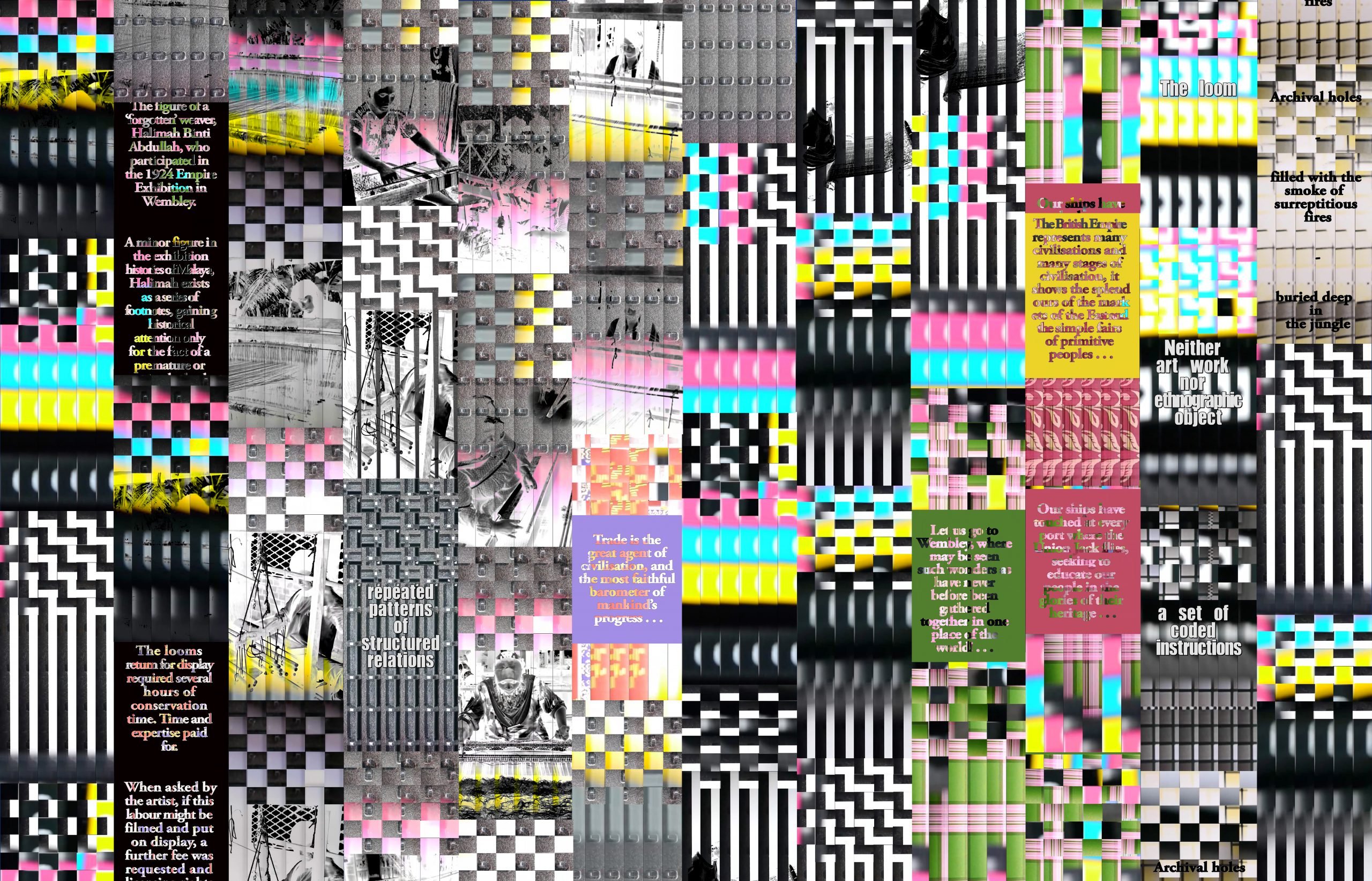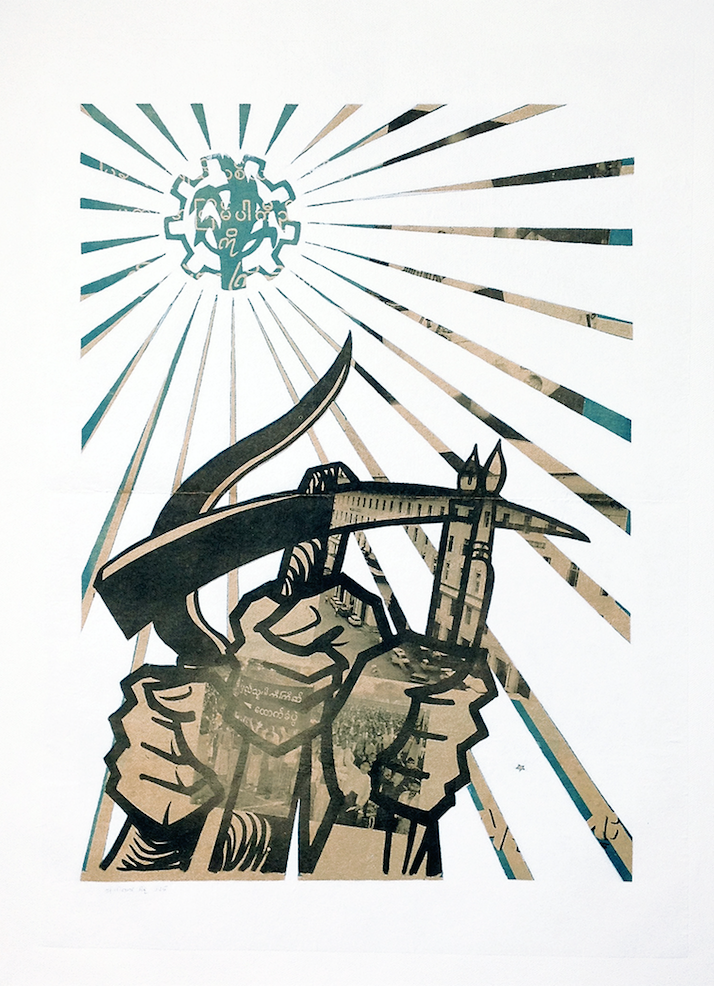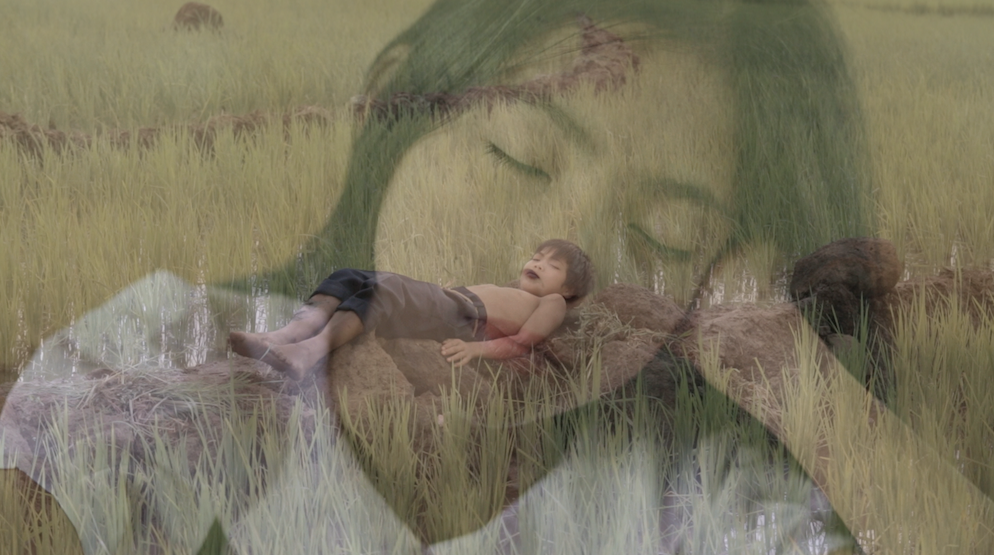
© » KADIST
Tuan Andrew Nguyen
This work presents the image of an immolated monk engraved on a baseball bat. The flames surround him eroding the extremity of the bat. The delicate sculpture refers to the sacrifice of the Buddhist monk, Thich Quang Duc, who immolated himself on June 16th 1963, in reaction to the discrimination and the repressive politics of the Diem Catholic regime (regime installed by the Americans) towards the Buddhists.

© » KADIST
Nguyen Thai Tuan
In the “Black Paintings” series, although the human body is only suggested, it plays an important role. Some body parts are absent, mostly the faces which are usually an affirmation of the individual. The characters recall ghosts testifying as to the traumas of war.

© » KADIST
UuDam Tran Nguyen
Like many Asian countries, Vietnam has lost an immense amount of natural environment and rural landscape to economic growth and industrial development. The single-channel video Waltz of the Machine Equestrians is a response to the overwhelming number of motorbikes and scooters overtaking the streets of Vietnam as small agrarian communities have been displaced by the construction of skyscrapers. The video shows 28 “equestrians” on motorbikes and scooters arrayed into a rainbow cavalcade held together by strings clipped onto brightly colored ponchos.

© » KADIST
Brook Andrew
This year: missing witness by Brook Andrew consists of a multi-layered collage of photographs. The work features newspaper cut-outs of the phrases: “This year: be prepared…” and “missing witness” overlaid onto a disaster scene, upon a worn-up manuscript. Pulled from The New York Times , the image is of a destroyed temple on the Indonesian island of Sulawesi, that has increasingly experienced natural disasters due to climate change.

© » KADIST
Andrew Grassie
In 2008, Grassie was invited by the Whitechapel Gallery to document the transformation of some of its spaces. The artist chose to depict the space before and after, thus creating the series titled “After the Archive Collections Room.” This group of paintings displays a space locked into time with its scaffolding and broom exposed, depicted just before an exhibition on a collection of archives.

© » KADIST
Andrea Bowers
Bowers’ Radical Hospitality (2015) is a sculptural contradiction: its red and blue neon letters proclaim the words of the title, signaling openness and generosity, while the barbed wires that encircle the words give another message entirely. Meant to hang from the ceiling, Bowers’ neon is further weighed down by long wind chimes made of aluminum pipes and wooden wind catchers that drip unsteadily from their anchors. Poetic but frantic in its juxtapositions, Bowers’ work captures a certain paradoxical energy that echoes the current political climate—it is hopeful but hindered, cacophonous but well intentioned, uncertain but ominous.
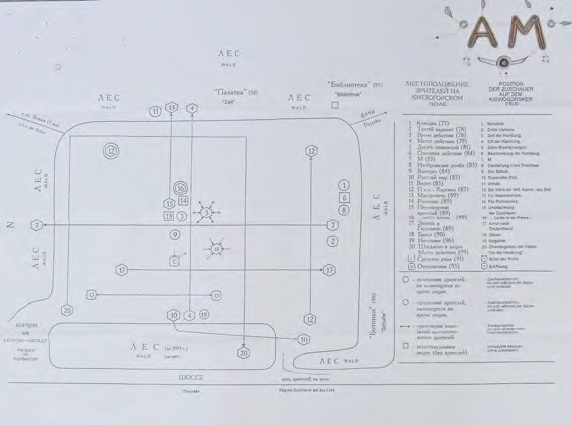
© » KADIST
Andrei Monastyrski
Drawing & Print (Drawing & Print)
Aktionsplan is a map of the field by Kyevy Gorky. Here Monastyrsky locates many of the iconic actions that occurred between 1977 and 1999. In this drawing, the static positions of the audience are marked with circles while the audience that re-locates is marked with hexagons as an arrow delineates their trajectory.

© » KADIST
Andrew Ekins
Butter Mountain is part of an ongoing series of works that combines a sense of painterly mass and substance with sculptural language to examine the synergy between a topographical landscape and a landscape of the human condition. The work intentionally alludes to the materiality of the human body and of the land. A stool has been consciously repurposed as a “support”, that by its nature and identity provides evidence of human presence.

© » KADIST
Andrew Norman Wilson
Z = |Z/Z•Z-1 mod 2|-1: Lavender Town Syndrome by Andrew Norman Wilson is a multi-channel video that uses three different imaging technologies—a photographic lens, photorealistic ray tracing animations, and fractal ray-marching animations—to travel through three constructed environments. The work’s subtitle, Lavender Town Syndrome, is named for a conspiracy theory in which more than 200 Japanese children were driven to suicide by a particular board in the game Pokémon Red and Green for Game Boy. Many others suffered serious migraines or nosebleeds, or turned violent when their parents tried to take the game away.

© » KADIST
Andrew Norman Wilson
On the first day of the Covid-19 lockdown in New York, Andrew Norman Wilson was evicted from his sublet and decided to board a $30 flight to Los Angeles that evening. From a cottage that faces the Hollywood sign, he began to dwell on an encounter he had with a woman driving alongside him on the highway, emphatically singing along to the song he was listening to through the same radio station. That song was Phil Collins’s “In the Air Tonight.” For Wilson, the uncanny synchronicity of this encounter with a stranger tuned into the same frequency resonated with the inspiration for Phil’s song, which he first heard as a teenager while getting high in a friend’s basement.

© » KADIST
Shen Yuan
Through a seemingly haphazard layering of glass and porcelain, Dérive is part of a larger installation series that address borders and displacement. Sheets of glass and porcelain, two transformational materials of alchemy, are stacked loosely in the shape of melting glaciers that places humans, animals, and nature in the same ecosystem. Migrations of one population into another and the subsequent displacement is emphasized in sharp, jagged edges of the transparent glass—phantasmagoric dreams of a distant place—the migration of not simply physical bodies but also that of political opinions and thoughts.

© » KADIST
Juan Araujo
Drawing & Print (Drawing & Print)
Many of Araujo’s works depict reproductions and Libro Ponti II is a recreation of a book on Italian architect Gio Ponti. Ponti designed the Villa Planchart a private, modernist house in Caracas, Venezuela, which at the time it was built in 1956, reflected the emergence of a class increasingly globalized, both culturally and economically. Araujo’s replica of the book thus refers to the role and visibility of Venezuela in circuits of global cultural production.
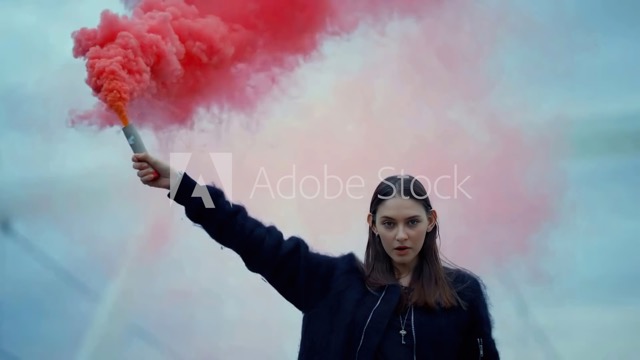
© » KADIST
Juan Obando
They/Them by Juan Obando is a video essay and deepfake that uses Adobe Stock clips, maintaining their branded watermark, but animating the scenes underneath with a narrative of self-critical awareness. It’s a meta-narrative that uses the staged scenarios (as evidence) to talk about the variable politics (and mercenary capitalism) of the stock footage industry and the misinformation dilemma we’re facing with the arrival of AI technology. In a surprising reversal, a deepfake is used to tell the truth.

© » KADIST
Guan Xiao
David is a five-minute pseudo music video that features an upbeat melodic soundtrack with a duet by the artist Guan Xiao and frequent collaborator (and KADIST collection) artist Yu Honglei. Three screens display a collection of home videos filmed and uploaded by tourists at the Galleria dell’Accademia in Florence capturing Michelangelo’s eponymous masterpiece. The mass popularity and commodification of this artwork is further exaggerated with the numerous forms that we encounter and consume the image or likeness of the sculpture in our daily lives.

© » KADIST
Juan Capistran
The Breaks reflects Capistran’s interests in sampling and fusing different cultural, social, and historical sources. Growing up in an African-American community in Los Angeles, Capistran has long been influenced by hip-hop culture. The photographs in this print document him surreptitiously breakdancing on Carl Andre’s iconic lead floor piece after the guards at the Los Angeles County Museum of Art have left the gallery.

© » KADIST
Euan Macdonald
The video 9000 PIECES by Euan Macdonald was filmed at a musical instrument factory in Shanghai where 90 percent of the pianos that they manufacture are exported around the world, and only 10 percent are “finished” and can be labeled “Made in the US (or) Europe.” The video captures an intricate network of mechanisms as they interact with each other, their rhythmic movements resulting in an intense choreography and a cacophony of metallic sounds dramatized by Macdonald’s editing. As the shot widens it reveals the process we see unfold: a piano being vigorously tested by a factory machine designed to determine the endurance of the instruments. Contrary to what is often relayed, the work has nothing to do with Chinese factories or fast changing global economies.

© » KADIST
Juan Covelli
El Salto (The Jump/The Waterfall) by Juan Covelli depicts the Salto de Tequendama, a waterfall located on the outskirts of southwest Bogota. During the 19th and 20th centuries, the waterfall served as a national symbol that captured both the singularity of its geographical reference point, as well as the romantic experience of nature and immensity. The video installation arises from a detailed archive research into historic representations of Colombian landscape and reflection on their role in the present-day imaginary of the country and the wider world.

© » KADIST
Nguyen 'Quoc' Thành
A Soldiers’ Garden by Nhà Sàn Collective is a night portrait series located in an army camp outside Hanoi. Here new recruits assemble for basic training during the first months of their military service, before they are relocated to their assigned battalion. Night is the only time the soldiers in training have a few moments for themselves.

© » KADIST
Nguyen Trinh Thi
Landscape Series no. 1 presents landscape as a “quiet witness of history.” It began with searches of online archives of Vietnamese news-media, for images of figures in landscapes “pointing, to indicate a past event, the location of something gone, something lost or missing.” The uniformity is striking but the sequence is subtly structured: the typology hints at narrative progression, though of an uninformative narrative, lacking details.

© » KADIST
Nguyen 'Quoc' Thành
A Soldiers’ Garden by Nhà Sàn Collective is a night portrait series located in an army camp outside Hanoi. Here new recruits assemble for basic training during the first months of their military service, before they are relocated to their assigned battalion. Night is the only time the soldiers in training have a few moments for themselves.

© » KADIST
Nguyen Trinh Thi
The essay film How to Improve the World by Nguyen Trinh Thi takes us into an indigenous village of the Jrai people in the Central Highlands of Vietnam, in Gia Lai province. It begins with sound – perhaps a hammer, or a gong – the lack of image making its identification difficult. A landscape emerges of an open field where a farmer tends his grazing cow herd.

© » KADIST
Phan Thao Nguyên
On September 22, 1940 the French signed an accord, which granted Japanese troops the right to occupy Indochina. The Japanese presence in Indochina lasted until the end of World War II and during the occupation, jute supplies from India were interrupted. Jute was used to make sacks as well as gunpowder, a crucial material for the war industry.

© » KADIST
Nguyen 'Quoc' Thành
A Soldiers’ Garden by Nhà Sàn Collective is a night portrait series located in an army camp outside Hanoi. Here new recruits assemble for basic training during the first months of their military service, before they are relocated to their assigned battalion. Night is the only time the soldiers in training have a few moments for themselves.

© » KADIST
Diane Severin Nguyen
To produce her photo and film works, Diane Severin Nguyen makes amalgam sculptures from found materials, both natural and synthetic. She captures these ephemeral constructions at close range, enlarging minute tensions. Nguyen uses transient, prosthetic lighting—the glow of sunset, an iPhone flash, battery-powered LEDs, fire—so that the camera intervenes moments before these temporary arrangements and their lighting change.

© » KADIST
Jun Nguyen-Hatsushiba
Filmed underwater, this is the third video in Nguyen-Hatsushiba’s “Memorial Project” series which began in 2001. The title already implies the cultural complexities about to be ironically unravelled: Ho Chi Minh is parodied and Okinawa (where this was filmed) was a battle site in Japan during World War II which then became an American training base during the Vietnam War. To a remix of James Bond movie tracks composed by Quoc Bao, no less than thirty divers in wet suits and full gear advance against the water resistance armed with cartridges of color.

© » KADIST
Andrey Shental
Descent into the Fungal is a two-channel video and a sculptural installation. The mushroom / sculptural element is site-specific and is grown from readymade mushroom blocks sold by mushroom farmers. They are given two weeks to mature and follow their natural cycle, bringing the natural element directly into the white cube.
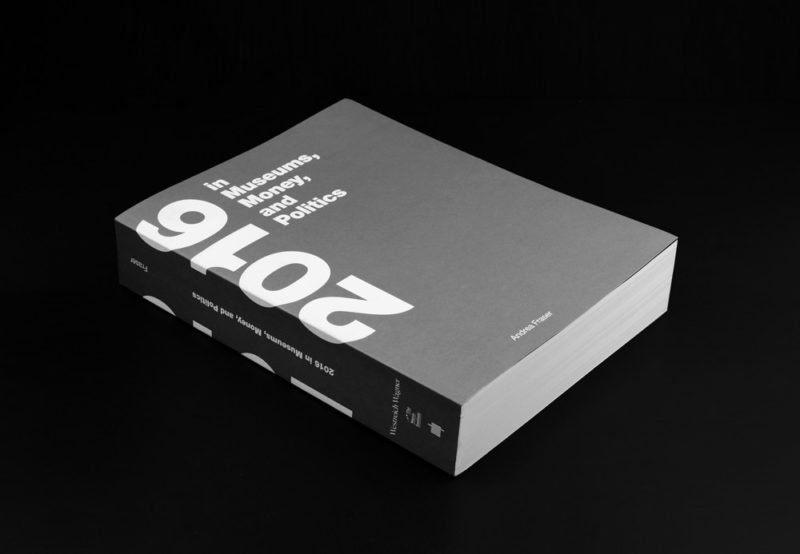
© » KADIST
Andrea Fraser
Drawing & Print (Drawing & Print)
The year 2016 is organized like a telephone book; the data corresponding to the contributions are classified in alphabetical order by the name of the donor. With this database as well as other types of information, the 900-page book presents a material representation of the scale of the cross over between cultural philanthropy and the financing of political campaigns in America. It also provides an unprecedented resource for discovering the political leaning of the museum sector.

© » KADIST
Andrea Bowers
Drawing & Print (Drawing & Print)
The small drawings that comprise Study from May Day March, Los Angeles 2010 (Immigration Reform Now) and We Are Immigrants Not Terrorists are based on photographs taken at a political rally in downtown Los Angeles in which thousands of individuals demonstrated for immigrants’ rights. The protesters and their supporters carried signs and wore t-shirts whose messages are highlighted in the drawings. However, in them, Bowers isolates the images of the protesters from the multitude that surrounds them in the original photographs, and, therefore amplifies their messages.

© » KADIST
Andrei Monastyrski
The series “The Golden lines” was started in 1996 and consists of photographs with “spiritual-transport” lines. While they resemble subway maps or star clusters, the lines mostly refer to ancient Chinese diagrams of Dao and inner alchemy. Both of the images are of undisclosed actions performed by Collective Actions on the field in Kyevy Gorky.
Juan Araujo
- year born: 1971
- gender: male
- nationality: Spanish
- home town: Caracas, Venezuela
Andrew Norman Wilson
Andrew Norman Wilson is an artist, curator, and filmmaker whose practice is mostly based in research and documentary...
Juan Capistran
- location: Los Angeles, California
- gender: male
- nationality: Mexican American
- home town: Guadalajara, Mexico
Xu Tan
- location: Amsterdam, Netherlands
- year born: 1966
- gender: female
- nationality: Dutch
- home town: Pekan Baru, Indonesia
Diane Severin Nguyen
Diane Severin Nguyen collects found objects and organic matter to craft the images in her photographs and video works...
Andrei Monastyrski
Artist, poet, writer and theoretician...
Guan Xiao
Guan Xiao is known for her videos composed primarily of found images and videos and her sculptures that explore the logic by which things relate to one another...
Andrea Bowers
- location: Los Angeles, California
- year born: 1965
- gender: female
- nationality: American
- home town: Wilmington, Ohio
Erika Tan
Erika Tan’s practice is primarily research-driven with a focus on the moving image, referencing distributed media in the form of cinema, gallery-based works, Internet and digital practices...
Nguyen Trinh Thi
Nguyen Trinh Thi is a moving image pioneer, not only within the landscape of contemporary art in Vietnam, but also broader South East Asia...
Lenka Clayton and Phillip Andrew Lewis
Lenka Clayton and Phillip Andrew Lewis’s collaborative practice is social at its core: it engages with and connects communities outside of the so-called art world in both production and presentation...
Andrey Shental
Andrey Shental is an independent artist, theorist, cultural critic, and curator based in Moscow...
UuDam Tran Nguyen
- nationality: Vietnamese
Andrew Ekins
Andrew Ekins’ work frequently deals with waste and recycling, using discarded materials to make something new...
Juan Obando
As a Colombian who studied and now lives in Arizona, Juan Obando has a non-native perspective on the media-obsessed culture of the US...
Jun Nguyen-Hatsushiba
- location: Vietnam
- year born: 1968
- gender: male
- nationality: Japanese-Vietnamese
- home town: Tokyo, Japan
Tuan Andrew Nguyen
Tuan Andrew Nguyen is an artist and filmmaker, one of the three founders of The Propeller Group created in 2006...
Juan Covelli
Juan Covelli uses technology as a medium;, striving to decolonize the museum through digital practices, he releases archives from institutional control for the sake of emancipation...
Andrew Thomas Huang
Andrew Thomas Huang is one of the most original upcoming film makers working at the intersection of tradition, spirituality, non-Western imaginary, queerness, and digital fantasies and technical possibilities...
Shen Yuan
Shen Yuan studied Chinese painting at the Zhejiang Academy of Fine Arts as the first group of students admitted after the Cultural Revolution...
Nguyen Thai Tuan
Nguyen Thai Tuan was born in 1965, he studied at the school of Fine Arts of Hue where he studied propaganda art, which he got bored of very quickly...
Tun Win Aung and Wah Nu
Wah Nu and Tun Win Aung, respectively born in 1977 and 1975, Yangon, Myanmar...
Brook Andrew
Brook Andrew is a Wiradjuri and Ngunnawal Aboriginal Australian artist and scholar whose interdisciplinary practice examines hegemonic narratives relating to colonialism and modernism...
Nguyen Phuong Linh
Phuong Linh Nguyen’s multidisciplinary practice spans video, sculpture and installation...
Ho Tzu Nyen
- location: Singapore
- year born: 1976
- gender: male
- nationality: Singaporean
- home town: Singapore
Juan Brenner
Born and raised in Guatemala, photographer Juan Brenner spent ten years in New York City working in the fashion industry before returning to his home country in 2008...
Andrew Grassie
- location: Edinburgh, United Kingdom
- year born: 1966
- gender: male
- nationality: British
Euan Macdonald
Euan Macdonald’s videos, drawings and sculptures are informed by a wide array of philosophical, musical, and literary references, but return repeatedly to the quotidian occurrence, the everyday as subject...
-
1990-1999
Andrei Monastyrski
Drawing & Print
1992(Drawing & Print) Aktionsplan is a map of the field by Kyevy Gorky...
-
2000-2009
Xu Tan
Drawing & Print
2000(Drawing & Print) Shanghai Biennale, Awaiting Your Arrival is an appropriation of the posters made to promote biennial art exhibitions...
Juan Capistran
2002The Breaks reflects Capistran’s interests in sampling and fusing different cultural, social, and historical sources...
Jun Nguyen-Hatsushiba
2003Filmed underwater, this is the third video in Nguyen-Hatsushiba’s “Memorial Project” series which began in 2001...
Xu Tan
Drawing & Print
2003(Drawing & Print) Biennale, Dog is an appropriation of the posters made to promote biennial art exhibitions...
Juan Capistran
2005White Minority , is typical of Capistran’s sampling of high art genres and living subcultures in which the artist subsumes an object’s high art pedigree within a vernacular art form...
Juan Araujo
Drawing & Print
2006(Drawing & Print) Many of Araujo’s works depict reproductions and Libro Ponti II is a recreation of a book on Italian architect Gio Ponti...
Andrei Monastyrski
2006The series “The Golden lines” was started in 1996 and consists of photographs with “spiritual-transport” lines...
Nguyen Thai Tuan
2008In the “Black Paintings” series, although the human body is only suggested, it plays an important role...
Andrew Grassie
2009In 2008, Grassie was invited by the Whitechapel Gallery to document the transformation of some of its spaces...
-
2010-2019
Euan Macdonald
2010The video 9000 PIECES by Euan Macdonald was filmed at a musical instrument factory in Shanghai where 90 percent of the pianos that they manufacture are exported around the world, and only 10 percent are “finished” and can be labeled “Made in the US (or) Europe.” The video captures an intricate network of mechanisms as they interact with each other, their rhythmic movements resulting in an intense choreography and a cacophony of metallic sounds dramatized by Macdonald’s editing...
Andrea Bowers
Drawing & Print
2010(Drawing & Print) The small drawings that comprise Study from May Day March, Los Angeles 2010 (Immigration Reform Now) and We Are Immigrants Not Terrorists are based on photographs taken at a political rally in downtown Los Angeles in which thousands of individuals demonstrated for immigrants’ rights...
Tun Win Aung and Wah Nu
2011Tun Win Aung and Wah Nu initiated the series 1000 Pieces (of White) in 2009, as a way to produce objects and images as a portrait of their shared life as partners and collaborators...
Ho Tzu Nyen
2011The Cloud of Unknowing (2011) is titled after a 14th-century medieval treatise on faith, in which “the cloud of unknowing” that stands between the aspirant and God can only be evoked by the senses, rather than the rational mind...
Tuan Andrew Nguyen
2012This work presents the image of an immolated monk engraved on a baseball bat...
UuDam Tran Nguyen
2012Like many Asian countries, Vietnam has lost an immense amount of natural environment and rural landscape to economic growth and industrial development...
Nguyen 'Quoc' Thành
2012A Soldiers’ Garden by Nhà Sàn Collective is a night portrait series located in an army camp outside Hanoi...
Nguyen 'Quoc' Thành
2012A Soldiers’ Garden by Nhà Sàn Collective is a night portrait series located in an army camp outside Hanoi...
Nguyen 'Quoc' Thành
2012A Soldiers’ Garden by Nhà Sàn Collective is a night portrait series located in an army camp outside Hanoi...
Juan Capistran
2012The 10 $1 bills that make up From a Whisper to a Scream (2012) read like instructions in origami...
Nguyen 'Quoc' Thành
2012A Soldiers’ Garden by Nhà Sàn Collective is a night portrait series located in an army camp outside Hanoi...
Nguyen 'Quoc' Thành
2012A Soldiers’ Garden by Nhà Sàn Collective is a night portrait series located in an army camp outside Hanoi...
Nguyen 'Quoc' Thành
2012A Soldiers’ Garden by Nhà Sàn Collective is a night portrait series located in an army camp outside Hanoi...
Nguyen 'Quoc' Thành
2012A Soldiers’ Garden by Nhà Sàn Collective is a night portrait series located in an army camp outside Hanoi...
Nguyen 'Quoc' Thành
2012A Soldiers’ Garden by Nhà Sàn Collective is a night portrait series located in an army camp outside Hanoi...
Juan Carlos Alom
2012In Amantes (Lovers) Juan Carlos points his lens at his own environment, his underground (literally) studio in Havana...
Phan Thao Nguyên
2013On September 22, 1940 the French signed an accord, which granted Japanese troops the right to occupy Indochina...
Tan Zi Hao
2013Tan Zi Hao produced Pest Control 1110, 709, 428 (or, a Myth for Another) , in response to the Bersih social movement, that catalyzed three rallies on 10th November 2007, 9th July 2011 and 28th April 2012, respectively, to demand a clean electoral roll...
Andrew Norman Wilson
2014Chase ATM emitting blue smoke, Bank of America ATM emitting red smoke, TD Bank ATM emitting green smoke was shot in the American Southwest at Mid-century modern architectural structures that were built to house regional independent banks and have since been bought up by Chase, Bank of America, and TD Bank...
Thu Van Tran
2014From Green to Orange is a series of silver films immersed in a bath of dye and rust...
Andrea Bowers
2015Bowers’ Radical Hospitality (2015) is a sculptural contradiction: its red and blue neon letters proclaim the words of the title, signaling openness and generosity, while the barbed wires that encircle the words give another message entirely...
Nguyen Phuong Linh
2016Set in the haunting space of an ex-colonial rubber plantation in Central Vietnam, Phuong Linh Nguyen’s film Memory of the Blind Elephant is a tender portrait of the complex economies of interspecies trauma and resilience in the face of continued extraction and destruction...
Andrew Ekins
2018Butter Mountain is part of an ongoing series of works that combines a sense of painterly mass and substance with sculptural language to examine the synergy between a topographical landscape and a landscape of the human condition...
Juan Brenner
2018The photographic series Tonatiuh (The Son of the Sun) by Juan Brenner is an in-depth visual study of current Guatemalan society from the perspective of miscegenation and the incalculable consequences of the Spanish conquest...
Andrés Pereira Paz
2018Juan III (Pescadores En Una Isla) is a series of embroideries made with fake pre-Columbian fabrics produced by the Gonzales family, a three-generation family of pre-Columbian textile “forgers” based in Lima, Peru...
Andrew Norman Wilson
2019In Andrew Norman Wilson’s work Kodak the artist uses computer-generated imagery to create narratives that question the reliability of images in the age of post-production...
Andrew Thomas Huang
2019Highly autobiographical, exquisitely made and compiling different aspects of the artist’s practice, Kiss of the Rabbit God is one of Andrew Thomas Huang’s most precise, relevant, and successful videos...
Diane Severin Nguyen
2019To produce her photo and film works, Diane Severin Nguyen makes amalgam sculptures from found materials, both natural and synthetic...
-
2020-2029
Brook Andrew
2020This year: missing witness by Brook Andrew consists of a multi-layered collage of photographs...
Andrew Norman Wilson
2020Z = |Z/Z•Z-1 mod 2|-1: Lavender Town Syndrome by Andrew Norman Wilson is a multi-channel video that uses three different imaging technologies—a photographic lens, photorealistic ray tracing animations, and fractal ray-marching animations—to travel through three constructed environments...
Andrew Norman Wilson
2020On the first day of the Covid-19 lockdown in New York, Andrew Norman Wilson was evicted from his sublet and decided to board a $30 flight to Los Angeles that evening...
Diane Severin Nguyen
2020To produce her photo and film works, Diane Severin Nguyen makes amalgam sculptures from found materials, both natural and synthetic...
Andrea Fraser
Drawing & Print
2020(Drawing & Print) The year 2016 is organized like a telephone book; the data corresponding to the contributions are classified in alphabetical order by the name of the donor...
Juan Covelli
2021El Salto (The Jump/The Waterfall) by Juan Covelli depicts the Salto de Tequendama, a waterfall located on the outskirts of southwest Bogota...
Nguyen Trinh Thi
2021The essay film How to Improve the World by Nguyen Trinh Thi takes us into an indigenous village of the Jrai people in the Central Highlands of Vietnam, in Gia Lai province...
Lenka Clayton and Phillip Andrew Lewis
2022Five Hundred Twenty-Four, a single-channel video installation by Lenka Clayton and Phillip Andrew Lewis, features singers from over twenty Cleveland-area choirs counting numbers in an iterative process: one person sings “one”, then two people sing “two”, and so forth, to 524...
Juan Obando
2023They/Them by Juan Obando is a video essay and deepfake that uses Adobe Stock clips, maintaining their branded watermark, but animating the scenes underneath with a narrative of self-critical awareness...



